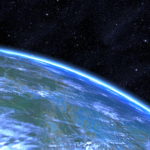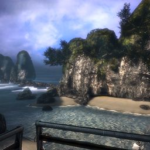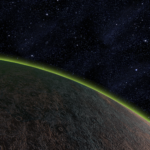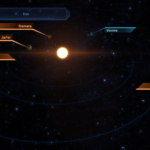System Specs:
- Stellar Mass: N/A Sol Masses
- Stellar Class: N/A
- Luminosity: N/A Sol
- Planets: 5
- Moons: 0
- Asteroid Belts: 0
- Asteroids: 0
- Objects: 0
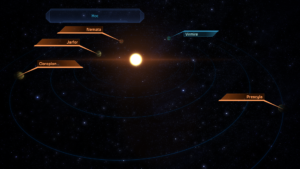
Hoc is a border system between the Attican Traverse and the Terminus Systems. While it is host to prime colonization and mining prospects like Virmire and Nemata, its proximity to the politically unstable Terminus Systems preclude long-term investment and development. It is known to have been visited by lawless elements as evidenced by giant batarian graffiti on Prescyla.
–
Planets Directory:
- Jarfor
- Nemata
- Virmire
- Cloroplon
- Prescyla
–
Jarfor:

- Orbital Distance: N/A AU
- Orbital Period: 1.3 Earth-years
- Keplerian Ratio: N/A
- Radius: 63,169 km
- Day Length: 1.3 Earth-hours
- Atmospheric Pressure: N/A atm
- Surface Temp: N/A °C
- Surface Gravity: N/A g
- Mass: N/A Earth-masses
Jarfor is a close-orbiting “hot Jupiter” hydrogen-helium gas giant with clouds of airborne silicate and deeper layers of sodium. In composition, it is extraordinarily similar to 51 Pegasi’s planet Bellerophon (one of the first extrasolar planets discovered by humanity in the late 20th century).
Despite its great size, Jarfor is actually rather low-mass; the incredible heat of the star Hoc has caused its atmosphere to expand. In fact, Jarfor is so low-mass, it is tidally locked to Hoc. The temperature difference between the sunward “hot pole” and the dark side “cold pole” creates constant hurricane-force winds.
–
Nemata:
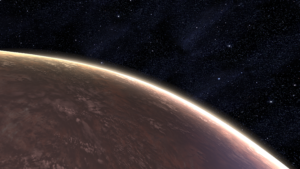
- Orbital Distance: N/A AU
- Orbital Period: 3.5 Earth-years
- Keplerian Ratio: N/A
- Radius: 7,318 km
- Day Length: 70.4 Earth-hours
- Atmospheric Pressure: 1.6 atm
- Surface Temp: 168 °C
- Surface Gravity: 1.4 g
- Mass: 1.829 Earth-masses
Nemata is a terrestrial planet with a thick, hazy atmosphere of ammonia, methane, and a cocktail of other hydrocarbon gasses. The surface is scorching hot, and mainly composed of nickel with deposits of iron.
With a density 1.4 times that of Earth, it is obvious that Nemata is rich with heavier elements. Mining could be extremely profitable, though the lethal heat and high gravity make initial development costly. Given the political instability of the nearby Terminus Systems, investment is unlikely.
–
Virmire:
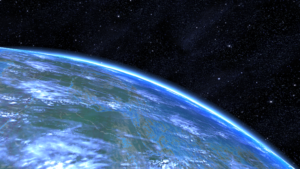
- Orbital Distance: N/A AU
- Orbital Period: 9.2 Earth-years
- Keplerian Ratio: N/A
- Radius: 6,440 km
- Day Length: 22.3 Earth-hours
- Atmospheric Pressure: 0.9 atm
- Surface Temp: 32 °C
- Surface Gravity: 0.86 g
- Mass: 0.87 Earth-masses
Virmire is a lush frontier world, ideal for colonization by carbon-based species. Its vast seas and orbital position on the inner life zone have created a wide equatorial band of humid, tropical terrain. Unfortunately, the political instability of the nearby Terminus Systems has impeded colonization efforts – the high risk of raids by pirates and slavers makes it an unappealing homestead.
Codex Entry
Virmire is a lush world located on the frontier of the Attican Traverse. Its vast seas and orbital position on the inner life zone have created a wide equatorial band of humid, tropical terrain. Only the political instability of the region has impeded efforts at colonization.
Many times, the Citadel has opened negotiations to settle Virmire with the various criminal gangs and petty dictatorships in the nearby Terminus Systems. All fell apart due to internal power shifts within the opposing parties. The Citadel has written off the colonization of Virmire as impossible without significant political change.
The Terminus powers themselves are unlikely to ever settle Virmire. Most lack the resources to support settlement of a virgin world, finding it more expedient to steal from their neighbors than build for themselves.
–
Cloroplon:
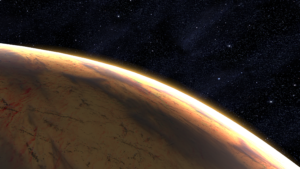
- Orbital Distance: N/A AU
- Orbital Period: 47.8 Earth-years
- Keplerian Ratio: N/A
- Radius: 32,191 km
- Day Length: 13.4 Earth-hours
- Atmospheric Pressure: N/A atm
- Surface Temp: N/A °C
- Surface Gravity: N/A g
- Mass: N/A Earth-masses
Cloroplon is a relatively small hydrogen-helium gas giant, with a haze of methane in the upper atmosphere.
Trivia
Cloroplon is too small to be a “hydrogen-helium gas giant” (William Hubbard, The New Solar System 4th ed, 1999; p. 194). It is more likely a dense “ice giant” like Neptune or Gliese 436 b.
–
Prescyla:
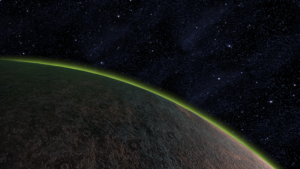
- Orbital Distance: N/A AU
- Orbital Period: 108.7 Earth-years
- Keplerian Ratio: N/A
- Radius: 2,075 km
- Day Length: 24.9 Earth-hours
- Atmospheric Pressure: 0.00 atm
- Surface Temp: −158 °C
- Surface Gravity: 0.1 g
- Mass: 0.011 Earth-masses
Prescyla is a terrestrial world so small, it cannot even retain a trace atmosphere. The surface is frozen and composed mostly of magnesium silicates with carbonaceous deposits.
In its recent past, a pirate gang from the Terminus Systems carved a message into the surface using ship-based laser weapons. In hundred-meter-wide batarian syllabic, the message proclaims the military prowess and virility of one “Captain Zaysh”. A smaller postscript alludes to the questionable parentage of all humans.
–
–
video



